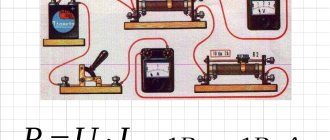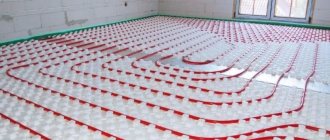Link to the archive of electricity tariffs in 2022 in Moscow and the Moscow region
The following types of tariffs apply in Moscow and the Moscow region:
The indicated tariff plans for electricity from Mosenergosbyt are valid from January 1, 2022 in the territory of the city of Moscow and the Moscow region. (RUB/kWh including VAT)
Electricity tariffs presented below in the tables for the population and equivalent categories of consumers in the city of Moscow and the Moscow region are indicated in the ratio rub./kWh and are divided into two periods: electricity tariffs from January 1, 2022 to June 30, 2022 and electricity tariffs from July 1, 2022 to December 31, 2022.
Electricity metering
An electric meter is a special device for metering alternating current electricity. There are such meters in every home, and they count not kilowatts or amperes, but kilowatt-hours. So, a kilowatt-hour is a non-system unit of measurement that demonstrates how much power in kilowatts an electrical appliance consumes in 1 hour of operation. It is for the kilowatt-hours that the meter registers that we pay the electricity producer. We can independently estimate the average daily electricity consumption in order to plan our spending on utilities.
Power consumption calculation
All household appliances have a special nameplate or sticker indicating the main electrical parameters. Most often, the maximum power that the device consumes at peak loads is indicated. Since gadgets and devices operate at maximum only a small part of the time, you can safely reduce the average power of the device by 25%. Let the following electrical appliances be present in the apartment:
- Refrigerator – 500 W;
- TV – 200 W;
- Laptop – 400 W;
- Washing machine – 2000 W;
- Microwave oven – 900 W.
This is the maximum level of power consumption from the electrical network. Moreover, if the TV as a whole has equal consumption, then the washing machine consumes different power depending on the washing mode. Knowing approximately how long each appliance runs each day or week, you can calculate kilowatt-hours. To do this, express the power in kilowatts and multiply by the average operating time:
- Refrigerator: 8 hours a day = 0.5 × 8 = 4 kW/h;
- TV: 2 hours a day = 0.2 × 2 = 0.4 kW/h;
- Laptop: 6 hours a day = 0.4 × 6 = 2.4 kW/h;
- Washing machine: 2 hours per week = 2 × 2 = 4 kW/h;
- Microwave: 10 minutes (0.16 hours) per day = 0.9 x 0.16 = 0.144 kWh.
For monthly consumption, it is enough to multiply each value by 28. The washing machine works 2 hours per week, not per day, so we multiply the power of the “washing machine” by 4. As a result, we get the total electricity consumption for the month:
4 × 28 + 0,4 × 28 + 2,4 × 28 + 4 × 4 + 0,144 × 28 = 210,43
Thus, 210.43 kW/h of electricity is consumed per week. Knowing the cost of one kW/h, it is easy to calculate how much it will cost to pay for electricity per month. However, do not forget about gadgets such as tablets, electronic cigarettes and mobile phones. They don't indicate how much power these devices consume, but it's easy to find out.
Tariffs in Moscow for apartments and houses without electric stoves with electric heating systems
| 01.01.2022 30.06.2022 | 01.07.2022 31.12.2022 | |
| Single-tariff accounting using a single-rate tariff | 5,15 | 5,43 |
| Two-tariff metering using a tariff differentiated by day zones | ||
| night zone T2 (23.00-7.00) | 1,74 | 1,88 |
| day zone T1 (7.00-23.00) | 5,92 | 6,24 |
| Multi-tariff metering using a tariff differentiated by day zones | ||
| night zone T2 (23.00-7.00) | 1,74 | 1,88 |
| half-peak zone T3 (10.00-17.00; 21.00-23.00) | 5,15 | 5,43 |
| peak zone T1 (7.00-10.00; 17.00-21.00) | 6,18 | 6,52 |
Determination of power by current consumption
How to determine the power consumption of a mobile device if its maximum power is not indicated on it? To do this, you need to know the voltage and current. The voltage of all electrical networks in the CIS is standard and is 220 V. However, chargers use a voltage of only 5 V.
The current consumed may vary. For mobile phones or tablets, 1 A chargers are usually used, and for electronic vapor generators (vape mods) - 2 A. It is known that it takes an average of 4 hours to fully charge a device. Thus, the mobile phone consumes:
and an electronic steam generator:
Consequently, we additionally spend about 1 kW/h per month to charge mobile devices.
Our program uses a similar calculation algorithm to determine energy costs. In this article, we calculated energy consumption manually. The calculator calculates everything automatically. You only need to indicate the operating time per day/week/month and the power of the selected electrical appliances. After this, indicate the cost of one kWh in your region and click the “Calculate” button. The program will display a table of electricity consumption and its cost per day/week/month/year.
You can also calculate the cost of electricity based on the amount of energy you already know. To do this, select the “Consumption” option in the calculator menu and indicate energy consumption in kWh for 1 year. For example, if you have printouts from your electricity supplier for your consumption during the previous year, you can use this value to run our calculator.
Electricity consumption of household appliances: table and tips for saving
The annual increase in the cost of electrical energy forces users to think about methods of controlling its consumption and ways to save. The instructions for any equipment indicate the power of the device. However, this is an average value and may vary depending on certain factors. You can learn how to correctly calculate the electricity consumption of household appliances from this article.
The more appliances you use in your home, the higher your energy costs will be.
Tariffs in the Moscow region for apartments and houses in rural areas
| 01.01.2022 30.06.2022 | 01.07.2022 31.12.2022 | |
| Single-tariff accounting using a single-rate tariff | 4,15 | 4,32 |
| Two-tariff metering using a tariff differentiated by day zones | ||
| night zone T2 (23.00-7.00) | 1,85 | 2,00 |
| day zone T1 (7.00-23.00) | 4,77 | 4,97 |
| Multi-tariff metering using a tariff differentiated by day zones | ||
| night zone T2 (23.00-7.00) | 1,85 | 2,00 |
| half-peak zone T3 (10.00-17.00; 21.00-23.00) | 4,15 | 4,32 |
| peak zone T1 (7.00-10.00; 17.00-21.00) | 5,40 | 5,62 |
Single-tariff accounting using a single-rate tariff for the population and equivalent categories in the Moscow region for 2022
| from 01.01.2022 to 30.06.2022 | from 07/01/2022 to 12/31/2022 | |
| Indicator (consumer groups broken down by rates and differentiated by day zones) | Price (tariff) in rub./kWh | Price (tariff) in rub./kWh |
| 1. Urban population | ||
| Around the clock | 5,93 | 6,17 |
| 2. Urban population living in houses equipped in the prescribed manner with stationary electric stoves and (or) electric heating installations | ||
| Around the clock | 4,29 | 4,60 |
| 3. Urban population living in houses equipped in the prescribed manner with stationary electric stoves and not equipped with electric heating installations | ||
| Around the clock | 4,29 | 4,60 |
| 4. Urban population living in houses equipped in the prescribed manner with electric heating installations and not equipped with stationary electric stoves | ||
| Around the clock | 4,29 | 4,60 |
| 5. Rural population | ||
| Around the clock | 4,15 | 4,32 |
| 6. Consumers equal to the population | ||
| Around the clock | 5,93 | 6,17 |
Two-tariff accounting using a tariff differentiated by day zones for the population and equivalent categories in the Moscow region for 2022
| from 01.01.2022 to 30.06.2022 | from 07/01/2022 to 12/31/2022 | |
| Indicator (consumer groups broken down by rates and differentiated by day zones) | Price (tariff) in rub./kWh | Price (tariff) in rub./kWh |
| 1. Urban population | ||
| Day zone (peak and half-peak) T1 07:00 - 23:00 | 6,82 | 7,10 |
| Night zone (peak and half-peak) T2 23:00 - 07:00 | 2,65 | 2,82 |
| 2. Urban population living in houses equipped in the prescribed manner with stationary electric stoves and (or) electric heating installations | ||
| Day zone (peak and half-peak) T1 07:00 - 23:00 | 4,93 | 5,29 |
| Night zone (peak and half-peak) T2 23:00 - 07:00 | 1,91 | 2,11 |
| 3. Urban population living in houses equipped in the prescribed manner with stationary electric stoves and not equipped with electric heating installations | ||
| Day zone (peak and half-peak) T1 07:00 - 23:00 | 4,93 | 5,29 |
| Night zone (peak and half-peak) T2 23:00 - 07:00 | 1,91 | 2,11 |
| 4. Urban population living in houses equipped in the prescribed manner with electric heating installations and not equipped with stationary electric stoves | ||
| Day zone (peak and half-peak) T1 07:00 - 23:00 | 4,93 | 5,29 |
| Night zone (peak and half-peak) T2 23:00 - 07:00 | 1,91 | 2,11 |
| 5. Rural population | ||
| Day zone (peak and half-peak) T1 07:00 - 23:00 | 4,77 | 4,97 |
| Night zone (peak and half-peak) T2 23:00 - 07:00 | 1,85 | 2,00 |
| 6. Consumers equal to the population | ||
| Day zone (peak and half-peak) T1 07:00 - 23:00 | 6,82 | 7,10 |
| Night zone (peak and half-peak) T2 23:00 - 07:00 | 2,65 | 2,82 |
Multi-tariff metering using a tariff differentiated by day zones for the population and equivalent categories in the Moscow region for 2022
| from 01.01.2022 to 30.06.2022 | from 07/01/2022 to 12/31/2022 | |
| Indicator (consumer groups broken down by rates and differentiated by day zones) | Price (tariff) in rub./kWh | Price (tariff) in rub./kWh |
| 1. Urban population | ||
| Peak zone T1 07:00 - 10:00; 17.00 - 21.00 | 7,71 | 8,03 |
| Half-peak zone T3 10:00 - 17:00; 21.00 - 23.00 | 5,93 | 6,17 |
| Night zone T2 23:00 - 07:00 | 2,65 | 2,82 |
| 2. Urban population living in houses equipped in the prescribed manner with stationary electric stoves and (or) electric heating installations | ||
| Peak zone T1 07:00 - 10:00; 17.00 - 21.00 | 5,58 | 5,98 |
| Half-peak zone T3 10:00 - 17:00; 21.00 - 23.00 | 4,29 | 4,60 |
| Night zone T2 23:00 - 07:00 | 1,91 | 2,11 |
| 3. Urban population living in houses equipped in the prescribed manner with stationary electric stoves and not equipped with electric heating installations | ||
| Peak zone T1 07:00 - 10:00; 17.00 - 21.00 | 5,58 | 5,98 |
| Half-peak zone T3 10:00 - 17:00; 21.00 - 23.00 | 4,29 | 4,60 |
| Night zone T2 23:00 - 07:00 | 1,91 | 2,11 |
| 4. Urban population living in houses equipped in the prescribed manner with electric heating installations and not equipped with stationary electric stoves | ||
| Peak zone T1 07:00 - 10:00; 17.00 - 21.00 | 5,58 | 5,98 |
| Half-peak zone T3 10:00 - 17:00; 21.00 - 23.00 | 4,29 | 4,60 |
| Night zone T2 23:00 - 07:00 | 1,91 | 2,11 |
| 5. Rural population | ||
| Peak zone T1 07:00 - 10:00; 17.00 - 21.00 | 5,40 | 5,62 |
| Half-peak zone T3 10:00 - 17:00; 21.00 - 23.00 | 4,15 | 4,32 |
| Night zone T2 23:00 - 07:00 | 1,85 | 2,00 |
| 6. Consumers equal to the population | ||
| Peak zone T1 07:00 - 10:00; 17.00 - 21.00 | 7,71 | 8,03 |
| Half-peak zone T3 10:00 - 17:00; 21.00 - 23.00 | 5,93 | 6,17 |
| Night zone T2 23:00 - 07:00 | 2,65 | 2,82 |
On the official website of Mosenergosbyt, in the tariffs and payment section, six menu items are presented: “Tariffs for Moscow”, “Tariffs for the Moscow region”, “Methods of payment for electricity”, “Information for the population about payments for electricity taking into account common household needs (ODN)”, “Benefits” and “Information on the value of the established social norm for the consumption of electrical energy (power) for the population”, in turn, in the “Tariffs” section there is a description of electricity tariffs in force in Moscow and the Moscow region, by clicking on the section with tariffs you need, you You will be able to familiarize yourself with them in more detail to calculate your electricity costs.
Based on this pricing, Mosenergosbyt provides electricity tariffs broken down by rates and day zones, based on the individual needs of its subscribers. There are one-, two- and multi-tariff charging systems. With a multi-tariff system, not only daytime and nighttime electricity consumption is taken into account, but also its peak hours.
Electricity for common house needs (GDN) and its calculation.
In the section “Information for the population about payments for electricity taking into account common building needs (CDN)” you can familiarize yourself with a detailed diagram of electricity costs in an apartment building.
The rules for the provision of utility services are reflected in Resolution No. 354 of the Government of the Russian Federation dated May 6, 2011 (as amended on February 27, 2017) “On the provision of utility services to owners and users of premises in apartment buildings and residential buildings.”
In addition to paying for individual electricity consumption, residents also need to pay for general house needs (CHN). Such amounts are calculated, accrued and allocated in the payment receipt separately from each other.
Payment for communal electricity in an apartment building is mandatory for everyone, does not depend on whether consumers have individual metering devices (IMU) and is proportional to the area of the premises they occupy.
If there is a common building meter, the volume of electricity supplied to the unit, subject to payment, is calculated by subtracting the total volume of individual consumption in all premises of the apartment building from the readings of the common building meter.
If a common house electricity meter is not installed, then the calculation of charges is carried out according to current standards.
Total power in W: how much energy do household appliances consume in kW
Any apartment is equipped with the necessary set of household appliances and electrical equipment. Each type of equipment has individual technical characteristics, including power and energy consumption. The total value of all these factors determines the total amount of electrical energy consumed, which will be different for each family.
Distribution of energy consumption by electrical appliances as a percentage.
In order to plan possible expenses, some owners resort to compiling a table of electricity consumption by household appliances per hour, where they indicate the name of the consumer, its power and duration of operation throughout the day. Information about the total energy consumption of household appliances and lighting elements is necessary for installing switching and protective equipment and selecting the cross-section of electrical wiring.
From the table below you can conclude which household appliances consume more electricity. These include a lighting system, refrigerator, TV, computer, washing machine, electric kettle and iron. The total value averages 120-180 kW per month. Additional costs include the use of small household appliances in the form of a hair dryer, coffee maker, food processor, chargers and other elements that provide the required level of comfort. In the summer, the use of air conditioning is also taken into account, and in winter - oil electric heaters, which add 60-100 kW.
Energy consumption table for household appliances
For each home, the number of electrical devices, the value of their electricity consumption and the duration of operation will be different. The table below for energy consumption of household appliances contains average information:
| Device name | power, kWt | Operating time per day, h | Consumption per day, kWh | Consumption per month, kWh |
| Fridge | 0,15-0,6 | 24 | 3,6-8,6 | 10,8-25,8 |
| Lighting (10 lamps 20 W each) | 0,020 | 5 | 0,1 | 3 |
| Washing machine | 1-2,2 | 1 | 1-2,2 | 20-30 |
| Vacuum cleaner | 0,65-2,2 | 15 minutes | 0,16-0,55 | 1,6-5,5 |
| TV | 0,1-0,3 | 5 | 0,5-1,5 | 15-30 |
| Microwave | 1,5 | 30 minutes | 0,75 | 10-15 |
| Electric kettle | 0,7-3 | 15 minutes | 0,25-0,75 | 7,5-16,5 |
| Computer | 0,1-0,2 | 5 | 0,5-1 | 7-20 |
| Iron | 1,1 | 15 | 0,3 | 5-8 |
| Dishwasher | 0,5-2,8 | 1 | 0,5-2,8 | 7,5-15 |
| Multicooker | 0,2-2,4 | 1 | 0,2-2,4 | 2-24 |
| Food processor | 0,2-2,0 | 15 minutes | 0,05-0,5 | 0,5-3 |
| Air conditioner | 0,7-1,3 | 7 | 3,5-8 | 15-35 |
| Hairdryer | 1,2-1,5 | 15 minutes | 0,3-0,4 | 5-7 |
| Heater | 1,5 | 5 | 7,5 | 75 |
| Electric stove | 2-8,5 | 3 | 5-10 | 30-150 |
| Coffee maker | 1,5-3,5 | 15 minutes | 0,3-0,8 | 5-10 |
| Hood | 0,1-0,5 | 3 | 0,3-1,5 | 3-4,5 |
Tariffs in Moscow for apartments and houses with gas stoves
| 01.01.2022 30.06.2022 | 01.07.2022 31.12.2022 | |
| Single-tariff accounting using a single-rate tariff | 5,92 | 6,17 |
| Two-tariff metering using a tariff differentiated by day zones | ||
| night zone T2 (23.00-7.00) | 2,48 | 2,69 |
| day zone T1 (7.00-23.00) | 6,81 | 7,10 |
| Multi-tariff metering using a tariff differentiated by day zones | ||
| night zone T2 (23.00-7.00) | 2,48 | 2,69 |
| half-peak zone T3 (10.00-17.00; 21.00-23.00) | 5,92 | 6,17 |
| peak zone T1 (7.00-10.00; 17.00-21.00) | 7,10 | 7,40 |
Refrigerator: how many watts does it consume per hour?
When answering the question of which electrical appliances consume the most energy, the refrigerator will be first on the list. This device works around the clock. The actual energy consumption of the refrigerator is calculated taking into account the international classification of energy efficiency devices. This parameter is designated by a letter with a certain number of pluses; the more there are, the lower the level of electricity use.
The classification of a household appliance by energy efficiency is as follows:
- A++ - the highest class with maximum energy saving. Electricity consumption is 30% of the standard value;
- A+ - energy consumption - 30-42% of the standard;
- A - energy consumption - 42-55% of the standard;
- B - energy consumption - 55-75% of the standard;
- C – energy consumption – 75-90% of the standard;
- D – energy consumption – 90-100% of the standard;
- E - energy consumption - 100-110% of the standard;
- F - energy consumption - 110-125% of the standard.
However, the energy efficiency parameter is very average. Since the amount of electricity consumed by the refrigerator is affected by its operating mode, workload, and the number of door openings.
The refrigerator consumes the most energy of any electrical appliance.
Annual energy consumption corresponds to 220-460 kW. It is impossible to obtain an accurate result for a table of electricity consumption per day or month by simply dividing this value. Since energy consumption is influenced by a number of factors, such as freezing power, ambient temperature, and product filling level.
To reduce the energy consumption of the refrigerator, it is necessary to operate the device correctly, do not leave the internal space empty when it is turned on, do not open the door for a long time, do not put hot food in, check the condition of the seals, ensure that there is a gap between the refrigerator and the wall, regularly defrost, wash and dry the unit.
How to calculate your TV's electricity consumption
A TV is an essential element of household appliances in every home. Often, owners install several copies for each room. Devices can be of several types: cathode ray tube models, LED, LSD or plasma TVs. The power consumption of a device is affected by its type, screen size, color, brightness, white and black balance, active operation time, and duration of sleep mode. Based on the table of electricity consumption by household appliances, a TV uses an average of 0.1-0.3 kW.
Electrical energy consumption will depend on the type and operating mode of the TV.
The power of TVs in Watts with a cathode ray tube is 60-100 W per hour. On average he can work about 5 hours a day. Monthly consumption reaches 15 kW. This is how much electricity will be spent on its active operation. The TV also consumes 2-3 watts per hour in standby mode when plugged in. Total energy consumption can be 16.5-17.5 kW per month.
The energy consumption of LED or LSD models directly depends on the screen size. For example, an LSD TV with a 32-inch screen diagonal will consume 45-55 W per hour in operating mode, and 1 W in standby mode. The total electricity consumption per month is 6.7-9 kW. LED models consume on average 35-40% less electrical energy. In active mode, a 42-inch TV will use 80-100 W, in sleep mode - 0.3 W. Total consumption per month will be 15-20 kW.
Plasma TVs have good color reproduction. The TV power in kW is 0.15-0.19 in active mode, and 120 W/day in sleep mode. The total consumption per month can be 30-35 kW. To save energy, you should remove the plug from the socket, correctly adjust the brightness level depending on the time of day, and set the timer to automatically turn off.
Tariffs in Moscow for apartments and houses with electric stoves without electric heating systems
| 01.01.2022 30.06.2022 | 01.07.2022 31.12.2022 | |
| Single-tariff accounting using a single-rate tariff | 5,15 | 5,43 |
| Two-tariff metering using a tariff differentiated by day zones | ||
| night zone T2 (23.00-7.00) | 1,74 | 1,88 |
| day zone T1 (7.00-23.00) | 5,92 | 6,24 |
| Multi-tariff metering using a tariff differentiated by day zones | ||
| night zone T2 (23.00-7.00) | 1,74 | 1,88 |
| half-peak zone T3 (10.00-17.00; 21.00-23.00) | 5,15 | 5,43 |
| peak zone T1 (7.00-10.00; 17.00-21.00) | 6,18 | 6,52 |
Washing machine operation: how many kilowatts does the device consume?
To calculate how many watts a washing machine spends on one wash cycle follows from the calculation of its brand, model and technical characteristics. Energy is spent on the operation of the electric motor, which can be in the range of 400-800 W, heating element - 2 kW, pump for draining water - 40 W, control system in standby mode - 3-10 W. This indicator directly depends on power consumption.
The higher the temperature the washing mode provides, the higher the energy consumption will be.
The washing mode also affects the total consumption. The lower the water temperature, device operating time and speed, the less electricity the machine will consume. Washing machines have an energy consumption class, which determines the required amount of electricity:
- class A+ - energy consumption 0.17 kWh;
- class A – 0.17-0.19 kWh;
- class B – 0.19-0.23 kWh;
- class C – 0.23-0.27 kWh;
- class D – 0.27-0.31 kWh;
- class E – 0.31-0.35 kWh;
- class F – 0.35-0.39 kWh;
- class G – more than 0.39 kWh.
Based on the class, model, mode, load and water temperature, the machine consumes 300-1600 Wh per washing cycle.
In order to reduce the amount of electricity consumed, it is necessary to choose the optimal mode, which will depend on the degree of soiling of the laundry and its composition. A significant part of the electricity is spent on heating water and spinning. The machine should be fully loaded, since the units cannot determine the relationship between the amount of laundry and the value of electricity consumption per cycle. The machine should be cleaned at least once every six months using special products.
Many washing machine models have water and energy saving modes.
Tariffs in the Moscow region for apartments and houses with gas stoves
| 01.01.2022 30.06.2022 | 01.07.2022 31.12.2022 | |
| Single-tariff accounting using a single-rate tariff | 5,93 | 6,17 |
| Two-tariff metering using a tariff differentiated by day zones | ||
| night zone T2 (23.00-7.00) | 2,65 | 2,82 |
| day zone T1 (7.00-23.00) | 6,82 | 7,10 |
| Multi-tariff metering using a tariff differentiated by day zones | ||
| night zone T2 (23.00-7.00) | 2,65 | 2,82 |
| half-peak zone T3 (10.00-17.00; 21.00-23.00) | 5,93 | 6,17 |
| peak zone T1 (7.00-10.00; 17.00-21.00) | 7,71 | 8,03 |
Electricity consumption of an electric stove
Electric stoves are very popular among consumers. The amount of electricity consumed by a device is affected by the type of hob, which can be induction or heating element, the diameter of the burners, the power and functionality of the device.
The power of a household appliance directly depends on the number of burners and their diameter, which can be 14.5; 18 and 20. Accordingly, energy consumption is 1; 1.5 and 2 kW.
The oven power corresponds to 1.8-4 kW. The minimum energy consumption with one operating burner is 1 kW. The maximum power of an electric stove is calculated taking into account the number of simultaneously operating burners and the operating mode of the oven. It can be 5-8.5 kW, as can be seen from the table of the power of household appliances and their energy consumption.
To save energy when operating an electric stove, you should follow some recommendations:
- it is necessary to choose the correct diameter of the pan for a specific burner;
- It is better to use dishes with a flat bottom;
- To save heat loss, the pan should be covered with a lid.
By following simple cooking rules, you can save energy consumption on your electric stove.
Tariffs in Moscow for apartments and houses in rural areas
| 01.01.2022 30.06.2022 | 01.07.2022 31.12.2022 | |
| Single-tariff accounting using a single-rate tariff | 4,14 | 4,32 |
| Two-tariff metering using a tariff differentiated by day zones | ||
| night zone T2 (23.00-7.00) | 2,20 | 2,38 |
| day zone T1 (7.00-23.00) | 4,76 | 4,97 |
| Multi-tariff metering using a tariff differentiated by day zones | ||
| night zone T2 (23.00-7.00) | 2,20 | 2,38 |
| half-peak zone T3 (10.00-17.00; 21.00-23.00) | 4,14 | 4,32 |
| peak zone T1 (7.00-10.00; 17.00-21.00) | 4,97 | 5,18 |
Single-tariff metering using a single-rate tariff for the population and equivalent categories of consumers in Moscow for 2022
| from 01.01.2022 to 30.06.2022 | from 07/01/2022 to 12/31/2022 | |
| Indicator (consumer groups broken down by rates and differentiated by day zones) | Price (tariff) in rub./kWh | Price (tariff) in rub./kWh |
| 1. Urban population | ||
| Around the clock | 5,92 | 6,17 |
| 2. Urban population living in houses equipped in the prescribed manner with stationary electric stoves and (or) electric heating installations | ||
| Around the clock | 5,15 | 5,43 |
| 3. Urban population living in houses equipped in the prescribed manner with stationary electric stoves and not equipped with electric heating installations | ||
| Around the clock | 5,15 | 5,43 |
| 4. Urban population living in houses equipped in the prescribed manner with electric heating installations and not equipped with stationary electric stoves | ||
| Around the clock | 5,15 | 5,43 |
| 5. Rural population | ||
| Around the clock | 4,14 | 4,32 |
| 6. Consumers equal to the population (gardening, gardening or dacha non-profit associations of citizens) | ||
| Around the clock | 4,14 | 4,32 |
| 7. Consumers equal to the population (with the exception of horticultural, gardening or dacha non-profit associations of citizens) | ||
| Around the clock | 5,92 | 6,17 |
Two-tariff metering using a tariff differentiated by day zones for the population and equivalent categories of consumers in Moscow for 2022
| from 01.01.2022 to 30.06.2022 | from 07/01/2022 to 12/31/2022 | |
| Indicator (consumer groups broken down by rates and differentiated by day zones) | Price (tariff) in rub./kWh | Price (tariff) in rub./kWh |
| 1. Urban population | ||
| Day zone (peak and half-peak) T1 07:00 - 23:00 | 6,81 | 7,10 |
| Night zone (peak and half-peak) T2 23:00 - 07:00 | 2,48 | 2,69 |
| 2. Urban population living in houses equipped in the prescribed manner with stationary electric stoves and (or) electric heating installations | ||
| Day zone (peak and half-peak) T1 07:00 - 23:00 | 5,92 | 6,24 |
| Night zone (peak and half-peak) T2 23:00 - 07:00 | 1,74 | 1,88 |
| 3. Urban population living in houses equipped in the prescribed manner with stationary electric stoves and not equipped with electric heating installations | ||
| Day zone (peak and half-peak) T1 07:00 - 23:00 | 5,92 | 6,24 |
| Night zone (peak and half-peak) T2 23:00 - 07:00 | 1,74 | 1,88 |
| 4. Urban population living in houses equipped in the prescribed manner with electric heating installations and not equipped with stationary electric stoves | ||
| Day zone (peak and half-peak) T1 07:00 - 23:00 | 5,92 | 6,24 |
| Night zone (peak and half-peak) T2 23:00 - 07:00 | 1,74 | 1,88 |
| 5. Rural population | ||
| Day zone (peak and half-peak) T1 07:00 - 23:00 | 4,76 | 4,97 |
| Night zone (peak and half-peak) T2 23:00 - 07:00 | 2,20 | 2,38 |
| 6. Consumers equal to the population (gardening, gardening or dacha non-profit associations of citizens) | ||
| Day zone (peak and half-peak) T1 07:00 - 23:00 | 4,76 | 4,97 |
| Night zone (peak and half-peak) T2 23:00 - 07:00 | 2,48 | 2,59 |
| 7. Consumers equal to the population (with the exception of horticultural, gardening or dacha non-profit associations of citizens) | ||
| Day zone (peak and half-peak) T1 07:00 - 23:00 | 6,81 | 7,10 |
| Night zone (peak and half-peak) T2 23:00 - 07:00 | 2,48 | 2,69 |
Multi-tariff metering using a tariff differentiated by day zones for the population and equivalent categories of consumers in Moscow for 2022
| from 01.01.2022 to 30.06.2022 | from 07/01/2022 to 12/31/2022 | |
| Indicator (consumer groups broken down by rates and differentiated by day zones) | Price (tariff) in rub./kWh | Price (tariff) in rub./kWh |
| 1. Urban population | ||
| Peak zone T1 07:00 - 10:00; 17.00 - 21.00 | 7,10 | 7,40 |
| Half-peak zone T3 10:00 - 17:00; 21.00 - 23.00 | 5,92 | 6,17 |
| Night zone T2 23:00 - 07:00 | 2,48 | 2,69 |
| 2. Urban population living in houses equipped in the prescribed manner with stationary electric stoves and (or) electric heating installations | ||
| Peak zone T1 07:00 - 10:00; 17.00 - 21.00 | 6,18 | 6,52 |
| Half-peak zone T3 10:00 - 17:00; 21.00 - 23.00 | 5.15 | 5,43 |
| Night zone T2 23:00 - 07:00 | 1.74 | 1,88 |
| 3. Urban population living in houses equipped in the prescribed manner with stationary electric stoves and not equipped with electric heating installations | ||
| Peak zone T1 07:00 - 10:00; 17.00 - 21.00 | 6,18 | 6,52 |
| Half-peak zone T3 10:00 - 17:00; 21.00 - 23.00 | 5.15 | 5,43 |
| Night zone T2 23:00 - 07:00 | 1.74 | 1,88 |
| 4. Urban population living in houses equipped in the prescribed manner with electric heating installations and not equipped with stationary electric stoves | ||
| Peak zone T1 07:00 - 10:00; 17.00 - 21.00 | 6,18 | 6,52 |
| Half-peak zone T3 10:00 - 17:00; 21.00 - 23.00 | 5.15 | 5,43 |
| Night zone T2 23:00 - 07:00 | 1.74 | 1,88 |
| 5. Rural population | ||
| Peak zone T1 07:00 - 10:00; 17.00 - 21.00 | 4,97 | 5,18 |
| Half-peak zone T3 10:00 - 17:00; 21.00 - 23.00 | 4,14 | 4,32 |
| Night zone T2 23:00 - 07:00 | 2,20 | 2,38 |
| 6. Consumers equal to the population (gardening, gardening or dacha non-profit associations of citizens) | ||
| Peak zone T1 07:00 - 10:00; 17.00 - 21.00 | 4,97 | 5,18 |
| Half-peak zone T3 10:00 - 17:00; 21.00 - 23.00 | 4,14 | 4,32 |
| Night zone T2 23:00 - 07:00 | 2,48 | 2,59 |
| 7. Consumers equal to the population (with the exception of horticultural, gardening or dacha non-profit associations of citizens) | ||
| Peak zone T1 07:00 - 10:00; 17.00 - 21.00 | 7,10 | 7,40 |
| Half-peak zone T3 10:00 - 17:00; 21.00 - 23.00 | 5,92 | 6,17 |
| Night zone T2 23:00 - 07:00 | 2,48 | 2,69 |
How much does an electric boiler consume?
Electric boilers are installed in houses for heating and water heating. However, the simplicity of the design and ease of operation hides high energy consumption. Models of electric boilers differ in power, design, number of circuits and method of heating the coolant (heating elements, electrode or induction heating). Double-circuit boilers are used for heating and water heating. Boiler models are more economical than flow-through ones.
The choice of boiler is made on the basis of the required power that it must have to ensure heating of premises of a given area. When calculating, it should be taken into account that kW is the minimum power of the device required to heat 10 sq.m. of room area. Additionally, climatic conditions, the presence of additional insulation, the condition of doors, windows, floors and the presence of cracks in them, and the thermal conductivity of walls are taken into account.
Air conditioner power consumption
The electricity consumption of an air conditioner directly depends on its operating mode. The device converts temperature using a heat pump, the operation of which is ensured by pumping a coolant, freon, with a compressor and changing the pressure in the lines. The coolant, depending on its operating mode (cooling or heating), passes from liquid to gaseous state in the outdoor or indoor unit.
The device goes into standby mode after reaching the set temperature. When it goes beyond the established standards, the air conditioner starts working again. The split system operates periodically, without consuming electricity in standby mode. Most of the energy is spent on operating the compressor and then the fan.
The air conditioner is selected based on its heating output, which is calculated in British thermal units. Converted to kilowatts, the following values are obtained:
- 7 – 2 kW;
- 9 – 2.5 kW;
- 12 – 3.5 kW;
- 18 – 5 kW.
The amount of energy consumed by an air conditioner will depend on the time of year and the room temperature.
Thermal power should not be confused with electrical power. To calculate electricity consumption per hour, you should divide the cooling capacity by 3. As the above table of power consumption of household electrical appliances suggests, air conditioners consume 0.7-1.3 kW per hour of active operation, which depends on the type of compressor.
Tariffs in Moscow for apartments and houses with electric stoves and electric heating systems
| 01.01.2022 30.06.2022 | 01.07.2022 31.12.2022 | |
| Single-tariff accounting using a single-rate tariff | 5,15 | 5,43 |
| Two-tariff metering using a tariff differentiated by day zones | ||
| night zone T2 (23.00-7.00) | 1,74 | 1,88 |
| day zone T1 (7.00-23.00) | 5,92 | 6,24 |
| Multi-tariff metering using a tariff differentiated by day zones | ||
| night zone T2 (23.00-7.00) | 1,74 | 1,88 |
| half-peak zone T3 (10.00-17.00; 21.00-23.00) | 5,15 | 5,43 |
| peak zone T1 (7.00-10.00; 17.00-21.00) | 6,18 | 6,52 |
How much electricity does a kettle consume?
An electric kettle is a convenient household appliance that can provide its owners with boiling water in a matter of minutes.
It is necessary to calculate how many kilowatts a kettle consumes, taking into account the power of the device and the maximum volume of liquid that it can bring to a boil. The larger the displacement of the device, the more time it will take to heat the water, and accordingly the amount of electricity consumed increases. On the other hand, the high power of the kettle contributes to its fast operation. However, it requires a sufficient amount of electricity.
All electric kettles are different in their parameters and, accordingly, in their level of energy consumption.
To calculate how much a kettle consumes, you should perform the following calculations:
- The power of the device is taken from the passport;
- the time it takes to boil water in the kettle is calculated;
- electricity consumption per unit time is determined;
- the resulting value should be multiplied by the number of times the water is boiled;
- monthly electricity consumption is determined.
Based on the table, the power of the electrical appliance is in the range of 700-3000 W, which depends on the volume of the bowl, body material, displacement, type of heating element, and chemical composition of the water. The heating element can be open (spiral) or closed (plate) type. The first option provides a high rate of water heating and, accordingly, uses less energy.
The energy consumption of the device is also influenced by the housing material. In a metal bowl, water heats up faster. However, an additional amount of electricity is spent on heating the case. Glass also heats up quickly, but retains heat less well. Ceramic has a slow heating rate, but the water in the kettle will remain hot for a long time.
To reduce the kettle's energy consumption, unplug the appliance from the outlet when not in use. The required volume of water should be poured into it, without reserve. You should monitor the condition of the heating element by regularly descaling it.
How to reduce energy consumption of household appliances
To reduce the electrical energy consumption of household appliances, there are several effective techniques. A good result is achieved by using an energy-saving refrigerator that can operate in this mode all year round, regardless of weather conditions.
It is better to organize the lighting system in the house using modern LED or energy-saving lamps. Their installation will not only save energy, they are also characterized by a longer operating period. A good effect is achieved by installing local lighting in the kitchen, bedroom, hallway, and living room, which also saves energy.
Refrigerators and freezers should be defrosted promptly. The presence of excess ice on the internal walls of devices increases energy consumption.
Tips for saving energy consumption.
While the computer is running, you can select the optimal power consumption mode for it. It will automatically turn off when left idle for a certain period of time. When exiting sleep mode, much less energy will be needed compared to normal switching on.
When operating heating devices, you can use heat-reflecting screens, which help increase heat transfer and reduce energy consumption.
When choosing household appliances, you should consider how many watts (kilowatts) the appliance consumes per hour. It is better to give preference to economical devices that will meet the stated requirements, while saving the energy resources necessary for their operation.











